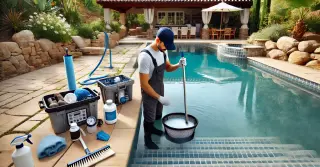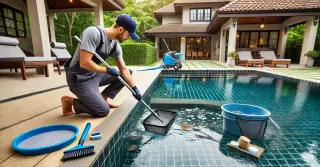Pool Chemical Balance Frederica DE

Ensuring the right chemical balance is crucial for a safe and healthy swimming environment. Balanced chemicals inhibit algae and bacteria, ensure clear water and protect pool surfaces and equipment.
- Balancing pH Levels: Your pool's pH level indicates its acidity or alkalinity. The ideal pH range is between 7.2 and 7.6. Low pH levels result in acidic water, causing skin irritation and equipment corrosion. Alkaline water from high pH causes cloudiness and scaling. Consistently testing and adjusting pH levels is essential to maintain a comfortable and safe swimming environment.
- Monitoring Chlorine Levels: Chlorine is a key component in pool sanitation, as it kills bacteria, algae, and other harmful microorganisms. The proper chlorine level is between 1-3 ppm. Too little chlorine can lead to unsanitary conditions, allowing bacteria and algae to thrive. High chlorine levels result in skin and eye irritation and cause a strong chlorine smell. Regularly testing and adjusting chlorine levels maintains sanitation and comfort.
Optimal Alkalinity LevelsTotal alkalinity plays a vital role in pool water balance. Alkalinity acts as a buffer for pH levels, preventing drastic pH fluctuations. The ideal range for total alkalinity is between 80-120 ppm.
- Avoiding pH Fluctuations: Proper alkalinity levels help stabilize pH levels, preventing rapid pH changes that irritate skin and damage surfaces. Low alkalinity results in unstable pH levels, making it difficult to maintain a consistent balance. If alkalinity is too high, it can make the water cloudy and lead to scaling. Consistently monitoring and adjusting alkalinity levels is crucial for stable and balanced water.
- Balancing Calcium Levels: Calcium hardness indicates the calcium level in pool water. Optimal calcium hardness levels are between 200-400 ppm. If calcium levels are too low, the water becomes corrosive, damaging pool surfaces and equipment. Excessive calcium causes scaling and water cloudiness. Regularly testing and adjusting calcium hardness is important for protecting your pool and ensuring clear water.
Safe Handling of Pool ChemicalsUsing and storing pool chemicals safely is vital for safety and chemical performance. Store chemicals in a cool, dry place, away from direct sunlight, children, and pets. Adhere to manufacturer guidelines for dosing and application.
- Proper Chemical Measurement and Mixing: Accurately measuring pool chemicals is vital for correct balance. Using too much or too little can imbalance chemicals and harm water quality. Always use a clean, dry measuring tool and never mix chemicals directly with each other. Mix chemicals in water if required, following the instructions carefully.
- Understanding Chemical Reactions: Some chemicals can react dangerously when combined. Never mix chlorine with acid, for example. Knowing these interactions prevents accidents and ensures safe handling. Store chemicals apart and handle each carefully to avoid harmful reactions.
Maintaining the proper chemical balance in your pool is crucial for safety, cleanliness, and enjoyment. By regularly testing and adjusting pH, chlorine, alkalinity, and calcium levels, you can keep your pool water in optimal condition.
Safe handling and storage of pool chemicals further ensure the health and safety of your pool and its users.




